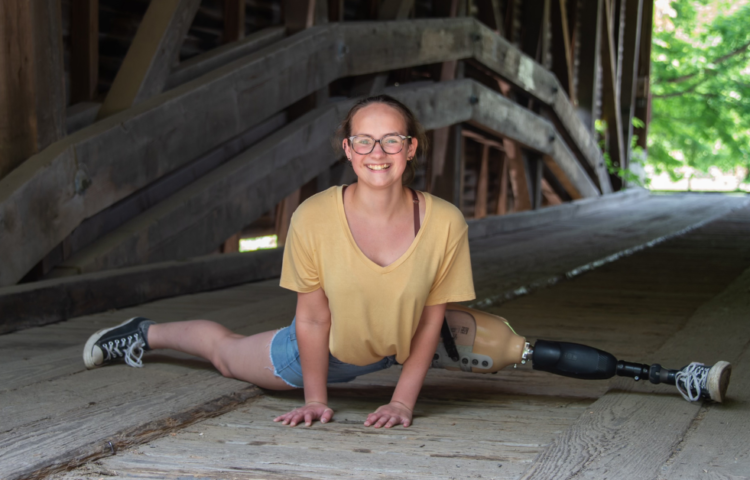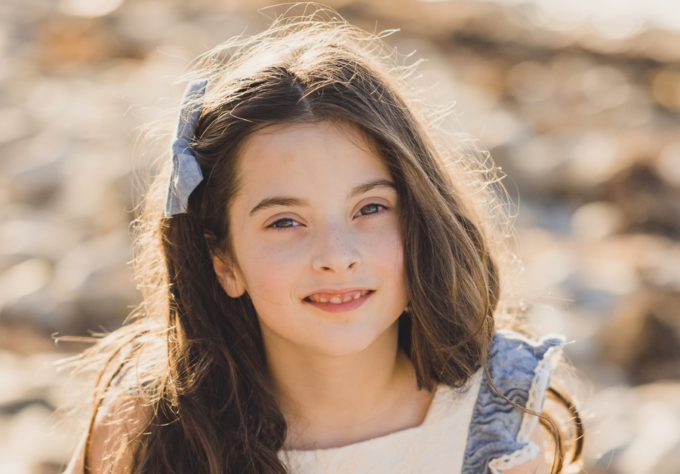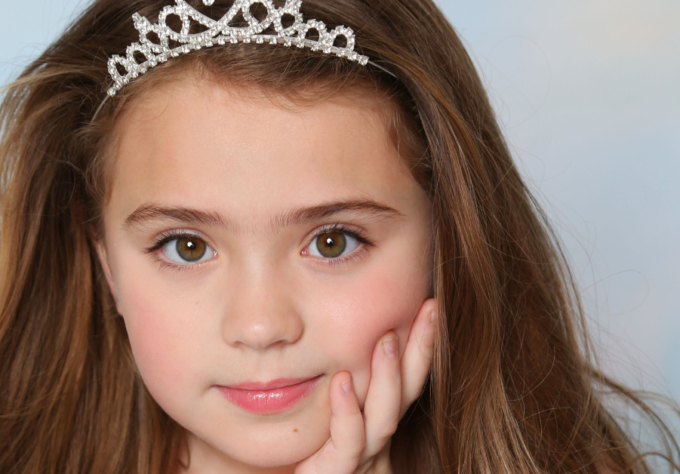Cara’s story started when she was very young, and her family sought medical help to understand why she fell often. After visits to various specialists, including optometrists, orthopedists, and neurologists, an MRI revealed a spinal cord tumor. Three days later, Cara underwent surgery, leaving her left leg without any feeling or ability to control movement.

This led to several years of KFO braces, rehabilitation, emotional processing, and accidental injuries that posed diagnostic challenges due to the lack of sensation in her leg. Cara received a diagnosis of Charcot joint in her knee, after numerous bone infections, surgeries, and prolonged hospital stays.
By the time Cara was entering the eighth grade, she decided she wanted her life to have more freedom from her diagnosis. Compiling her thoughts into a comprehensive letter, Cara presented her case for leg amputation to Elizabeth W. Snyder Endowed Chair in Osteogenesis Imperfecta, Dr. Jeanne Franzone, and her Nemours Children’s Hospital, Delaware team. “I wrote a four-page essay to my doctors and presented my case for amputating my leg to Dr. Franzone and the rest of the prosthetics team,” says Cara. “They immediately agreed, and I had the surgery the summer before I started high school. It was the scariest but best decision I ever made. Also, I have been spinal tumor free for over 10 years!”
Before her amputation, Cara’s diagnosis significantly impacted her everyday life. “My KFO brace broke all the time because I was a very active child,” says Cara. “Dr. Lawall’s office was always so kind about fixing it and helping to keep me out of a wheelchair whenever possible. To this day, my wheelchair is my least favorite medical aid (even though I know it’s necessary at times)!” As a competitive swimmer, she faced challenges with her knee’s inability to bend prior to her amputation, particularly in executing flip turns, leading to slower times. Though her coaches offered adaptations, Cara struggled to see progress in her beloved sport. Additionally, the only shoes Cara could wear over her brace were Converse. The soles of the shoes would develop holes near the heel due to the pressure of her walk. “One time, my parents took our family to a Broadway show in New York,” Cara remembers, “My dad studied the seating chart when buying tickets to try and find a spot that would accommodate my straight leg. When we got there, I couldn’t fit in the seat. We had to find an usher who had to ask a family of strangers if we could switch with them. They were happy to do so, but I never wanted to do something like that again. I think I started my essay to my doctors that weekend.”

Cara and her family appreciate the convenience of having multiple specialists under one roof at Nemours Children’s. This consolidated approach proved especially beneficial during Cara’s time at the spinal dysfunction clinic, where she was assigned an examination room allowing 4-5 doctors to sequentially attend to her needs. This streamlined process not only saved time, but also facilitated comprehensive care. Currently, Cara attends the prosthetic clinic at the Nemours Gait Lab which offers a similar level of efficiency. The entire care team convenes to discuss Cara’s progress, providing her with personalized attention while eliminating the need for multiple appointments and ensuring all questions are addressed in one session.
Forming bonds with her doctors proved crucial for Cara. “Having strong connections with my doctors has been the key to both my decision to amputate and my mental health,” says Cara. Dr. Franzone, in particular, shared her sense of humor, engaging in playful pranks like hiding plastic spiders in bandages and joining in on creative antics during her hospital stays. These connections became lifelines, especially during periods of restricted visitations. “I spent my 13th birthday in the hospital and the day before, Kim, my Child Life Coordinator, and I baked a cake,” says Cara. “My sister and extended family weren’t allowed in, but they came and made signs and waved at my window and enjoyed my cake.”

After her amputation, Cara began practicing her balance on a Slack Block. “It’s very hard to do,” says Cara. “Soon, every doctor and nurse and staff member seemed to find their way into my room to give it a try too. They kept a record of who could stand the longest on my room’s whiteboard. Their goal was to make it for 5 minutes, but I easily did 30 and they couldn’t figure out how I did it! When one of my 3 West nurses made it for the whole 5 minutes, we celebrated with ice cream. Having the steady stream of hospital staff enjoying the competition really helped with not being allowed visitors.”
When asked about Cara’s post-amputation journey, her mother always responds, “Cara is living the life she was always meant to have.” Cara echoes this sentiment, acknowledging that life post-amputation hasn’t been without challenges, including occasional bone infections and injuries requiring wheelchair use during recovery periods. Despite setbacks like missing her sophomore homecoming dance due to an ER visit for an infection, Cara embraces these experiences. “Those things will always be a part of my life and even with them, I can’t remember ever feeling happier about who I am than I do now,” says Cara.
“I have big plans for my future,” says Cara. She was recently accepted into her high school’s Agricultural Sciences program and named a Scholastic All-American for USA Swimming in 2022-2023. Additionally, Cara participated in the US Paralympics Swimming National Championships in Orlando in December 2023, where she secured top 16 placements in all her events. “I have qualified for Maryland High School State Swimming Championships both my freshman and sophomore year amongst able-bodied swimmers,” shares Cara. “After high school, I want to study biology as an undergrad and pursue cytogenetics in a Masters Program. I also hope to find a college swim team that will help me pursue a spot on the US Paralympic Team, hopefully in 2028.”

When asked what advice she would give to others in a similar situation, Cara says, “Everything is a risk. Nothing is all good. There are still days where being an amputee is hard, but it was so worth it for me. I’d also say, don’t be afraid to ask for help and tell your doctors what you want. I feel very comfortable suggesting compromises with Dr. Franzone when I am recovering medically. Sometimes I get what I want, but she always listens to my attempts to bargain. Finally, I’d say, have someone to talk to. I’m an introvert and talking wasn’t something I thought I needed because I got what I wanted medically, but once I took advantage of Nemours Children’s Psychologist, Dr. Enlow, and his great advice, my highs and lows got easier to manage.” “In my letter to my doctors, I told them I wanted to: 1) Do flip turns and record faster times in the water. Done. 2) Sit in the bleachers at a high school football game with my friends. Done. 3) Wear heels to prom. I’m still working on that one, but I have improved my shoe selections dramatically since my prosthetic so I’m counting it as a win!”



